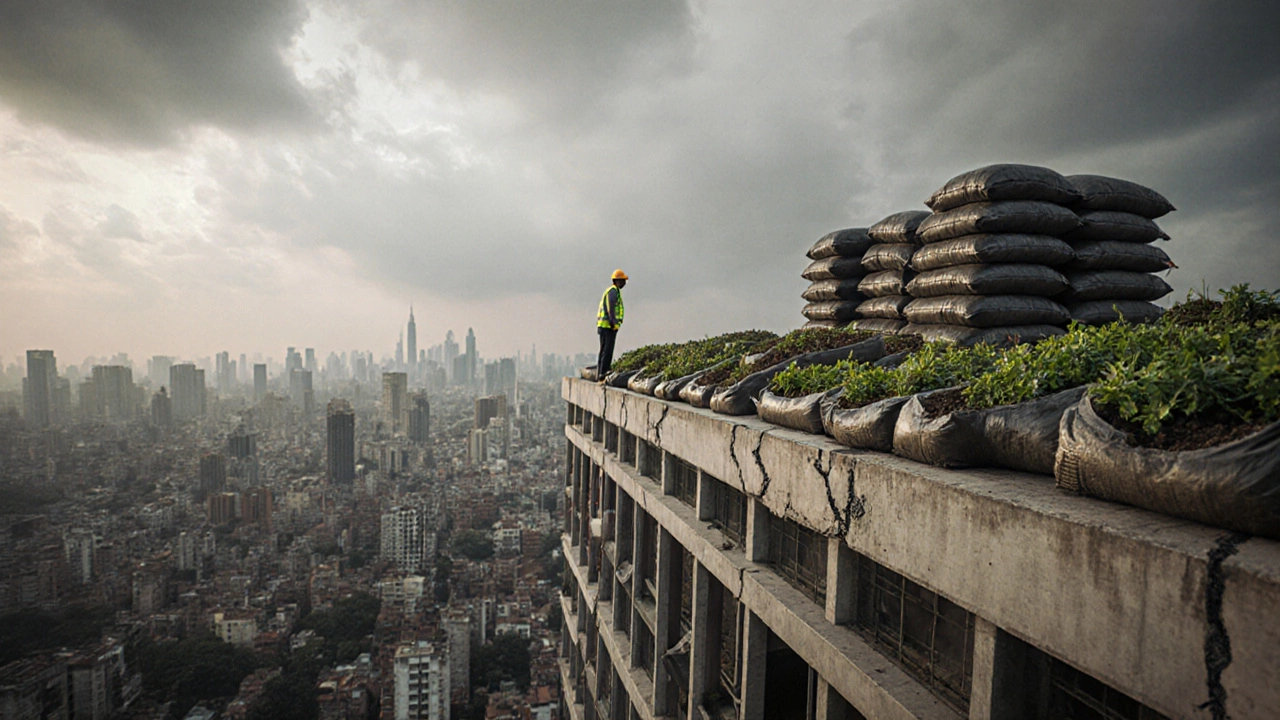The Hidden Drawbacks of Rooftop Farming

The Hidden Drawbacks of Rooftop Farming
Rooftop Farming Feasibility Calculator
Estimate the feasibility and cost of starting a rooftop farm based on your inputs below.
Rooftop farming is a form of urban agriculture that turns flat roof spaces into vegetable, herb, or flower beds. While the idea sounds green and profitable, the reality brings a laundry list of practical hurdles.
Quick Take
- Structural load limits can jeopardize building safety.
- Water runoff and leakage risk costly repairs.
- City regulations and insurance requirements add red tape.
- Initial setup and ongoing maintenance are pricey.
- Wind, heat, and shallow soil create stressful growing conditions.
1. Structural Load Limits
Every roof has a structural load capacity-the maximum weight it can safely bear. A typical residential roof is designed for about 20‑30kg/m² of dead load. Fill it with soil, containers, irrigation systems, and a mature plant, and you can easily exceed that figure. When the load is too high, the roof may sag, leak, or even collapse, leading to expensive engineering assessments and repairs.
2. Water Management Nightmares
Water is both a lifeline and a liability on a roof. Improper irrigation can cause:
- Excess runoff that overwhelms city storm‑drain systems.
- Leaking through membrane seams, damaging interior ceilings.
- Accelerated corrosion of metal roofing materials.
Managing these risks requires waterproofing layers, drainage mats, and a well‑designed gutter system-each adding to the rooftop farming cons list.
3. Regulatory and Insurance Hurdles
Most municipalities treat rooftop farms as commercial enterprises. That means you’ll need building permits, zoning approvals, and sometimes a change‑of‑use application. Insurance premiums also rise because insurers view roofs with gardens as higher‑risk properties. The paperwork alone can stall a project for months and increase upfront costs.
4. High Initial and Ongoing Costs
Setting up a roof garden isn’t cheap. You’ll spend money on:
- Structural reinforcement (engineer fees, additional joists).
- Waterproof membranes and drainage infrastructure.
- Light‑weight growing media (often a mix of peat, perlite, and compost).
- Container systems, benches, and safety railings.
- Automated irrigation and sensors to monitor moisture.
Maintenance adds another layer-regular soil refresh, pest scouting, and component replacement can total 10‑15% of the initial investment each year.

5. Microclimate Stresses
Rooftops heat up faster than ground‑level gardens. The “heat island” effect can raise temperatures by 5‑10°C, causing:
- Faster water evaporation, demanding more frequent watering.
- Heat‑stress on delicate greens, leading to wilting or bolting.
Wind exposure is another factor. Without natural windbreaks, gusts can shred leaves, break stems, or dry out soil in minutes. Shading structures mitigate heat, but they also cut sunlight and add cost.
6. Soil Depth and Nutrient Limitations
Because roofs can’t support deep loads, most growers use shallow containers or lightweight mixes with a depth of 15‑30cm. Shallow media holds less water and fewer nutrients, meaning you’ll need more frequent fertilization and careful crop selection-root vegetables and deep‑rooted plants become impractical.
7. Pest and Disease Management Challenges
Rooftop farms sit above the street, so they’re exposed to airborne spores, insects riding on the wind, and sometimes birds that feast on ripening fruit. Chemical controls are limited because of runoff concerns, pushing you toward organic methods that require more monitoring and labor.
Mitigation Strategies If You Still Want to Try
- Hire a structural engineer to verify load capacity and add reinforcements where needed.
- Install a multi‑layer waterproofing system with a dedicated drainage mat.
- Choose lightweight, high‑water‑retention media like a coconut coir‑perlite blend.
- Use modular container systems that allow easy removal for inspection.
- Implement automated drip irrigation with moisture sensors to avoid over‑watering.
- Add windbreaks-lattice panels, trellises, or tall grasses-to reduce gust impact.
- Select heat‑tolerant, shallow‑rooted crops such as lettuce, herbs, and dwarf tomatoes.
- Work with local authorities early to secure permits and understand insurance implications.
Summary Table of Common Cons
| Category | Specific Issue | Impact Level |
|---|---|---|
| Structural | Load exceeding roof capacity | High |
| Water Management | Runoff leakage and drainage failures | High |
| Regulatory | Permits, zoning, insurance premiums | Medium |
| Cost | Up‑front infrastructure and ongoing maintenance | Medium |
| Microclimate | Heat island, wind exposure | Medium |
| Soil & Nutrition | Shallow media, frequent fertilization | Low |
| Pests & Disease | Airborne pests, limited chemical options | Low |
Frequently Asked Questions
Do I need a professional engineer before starting a roof garden?
Yes. A qualified structural engineer can assess the existing roof’s load capacity and recommend reinforcements if needed. Skipping this step is a common cause of costly failures.
Can I use regular garden soil on a rooftop?
No. Traditional soil is too heavy. Most rooftop growers opt for lightweight mixes-often a blend of coconut coir, perlite, and compost-that provide drainage while staying within load limits.
What crops perform best on roofs?
Shallow‑rooted, fast‑growing varieties such as lettuce, spinach, basil, and dwarf cherry tomatoes thrive. Deep‑rooted veggies like carrots or potatoes usually aren’t practical.
How do I prevent water leakage?
Install a waterproof membrane, a drainage mat, and a well‑planned gutter system. Regularly inspect seams and replace any cracked sections promptly.
Is rooftop farming worth the investment?
It depends on your goals. If you value local food, green branding, or educational outreach, the benefits may outweigh the cons. For profit‑driven operations, the high upfront costs and ongoing maintenance often make ground‑level farms more economical.
About
Gardener Support India is your go-to online destination for expert advice on gardening and horticultural services in India. Whether you're a beginner or an experienced gardener, our platform offers extensive resources, tips, and support tailored to Indian climates and plant species. Explore a wide range of guides on plant care, sustainable gardening practices, and innovative gardening solutions. Connect with local experts to enhance your gardening experience and maintain a flourishing garden. Our dedicated services aim to empower Indian gardeners with the knowledge and tools needed for a successful gardening journey.
Latest Posts


Eco-Friendly Yard Ideas: Sustainable Tips for a Greener Outdoor Space
By Alden Thorne Jul 17, 2025

Eco Friendly Garden: How to Start One Step-by-Step
By Alden Thorne May 31, 2025

How to Fill a Raised Garden Bed Cheaply: Soil Hacks That Save Big
By Alden Thorne Apr 27, 2025

Write a comment